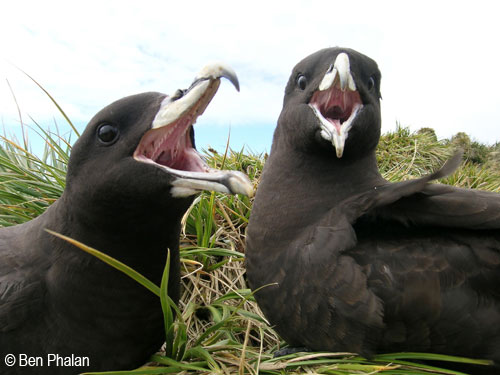Alice Carravieri (Centre d’Etudes Biologiques de Chizé, Université de La Rochelle, Villiers-en-Bois, France) and colleagues have published in the Journal Marine Biology on utilizing seabird feathers, including of the ACAP-listed White-chinned Petrel Procellaria aequinoctialis, to assess chemical composition as a way of monitoring marine health.
The paper’s abstract follows:
“One major limitation in the use of body feathers of seabirds as a monitoring tool of the trophic structure and contamination levels of marine ecosystems is the degree of heterogeneity in feather chemical composition within individuals. Here, we tested the hypothesis that moulting patterns drive body feather heterogeneity, with synchronous moult minimizing within-individual variations, in contrast to asynchronous feather growth. Chicks of white-chinned petrels Procellaria aequinoctialis (representative of bird chicks) and adults of king penguins Aptenodytes patagonicus (representative of adult penguins) that moult their body feathers synchronously showed very low within-individual variations in their feather δ13C and δ15N values and mercury (Hg) concentrations. By contrast, body feathers of adults of Antarctic prions Pachyptila desolata (representative of adult seabirds with asynchronous feather growth during a protracted moult) presented much higher within-individual variances for the three parameters. These findings have three important implications for birds presenting a synchronous body moult. (1) They suggest that all body feathers from the same individual have identical δ13C and δ15N values and Hg content. (2) They predict negligible within-individual variations in the body feather values of other useful stable isotopes, such as δ2H and δ34S, as well as in the concentrations of other compounds that are deposited in the keratin structure. (3) Analysis of one or any number of pooled body feathers is equally representative of the individual. In conclusion, we recommend that long-term routine monitoring investigations focus on birds presenting synchronous rather than asynchronous moult of body feathers both in marine and terrestrial environments. This means targeting chicks rather than adults and, for seabirds, penguins rather than adults of flying species.”

White-chinned Petrels, photograph by Ben Phalan
Reference:
Carravieri, A., Buastamante, P., Churlaud, C., Fromant, A. & Cherel, Y. 2014. Moulting patterns drive within-individual variations of stable isotopes and mercury in seabird body feathers: implications for monitoring of the marine environment. Marine Biology 161: 963-968.
John Cooper, ACAP Information Officer, 03 September 2014

 English
English  Français
Français  Español
Español